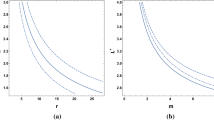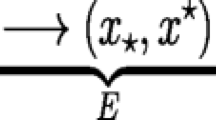Summary
The results of simulation experiments with a stochastic model incorporating internal and external sources of heterogeneity suggest that the western tent caterpillar is a risk spreader of a type discussed byDen Boer (1968). By maintaining physiological plasticity in its population,M.c. pluviale can survive periods of bad weather and then expand rapidly in an improved climate. Intrinsic variability in the moths’ dispersal capacity also ensures that some will continue to contribute to populations in the climatic refuges where the species persists during unfavorable periods, while others can quickly colonize marginal areas as soon as favorable conditions return. This northern population of the western tent caterpillar seems distinctly less well adapted to a world in which the terrain and the weather are more homogeneous than on the Saanich Peninsula.
Similar content being viewed by others
References
Birch, L. C. (1970) The role of environmental heterogeneity and genetical heterogeneity in determining distribution and abundance.Proc. Adv. Study Inst. Dynamics Numbers Popul. (Oosterbeek, 1970), 109–128.
Boer, P. J. Den (1968) Spreading of risk and stabilization of animal numbers.Acta biotheor.18: 165–194.
Boer, P. J. Den (1970) Stabilization of animal numbers and the heterogeneity of the environment: the problem of the persistence of sparse populations.Proc. Adv. Study Inst. Dynamics Numbers Popul. (Oosterbeek, 1970), 77–97.
Bryant, E. H. (1974) On the adaptive significance of enzyme polymorphisms in relation to environmental variability.Amer. Nat.108: 1–19.
Carr, A. andL. Ogren (1960) The ecology and migration of sea turtles. IV The green turtle in the Caribbean Sea.Bull. Amer. Mus. Natur. Hist.121: 1–48.
Cavalli-Sporza, L. L. (1974) The role of plasticity in biological and cultural evolution.Ann. N.Y. Acad. Sci.231: 43–59.
Christiansen, F. B. (1974) Sufficient conditions for protected polymorphism in a subdivided population.Amer. Nat.108: 157–166.
Cockerell, T. D. A. (1934) ‘Mimicry’ among insects.Nature133: 329–330.
Cody, M. L. (1966) A general theory of clutch size.Evolution20: 174–184.
Cohen, D. (1966) Optimizing reproduction in a randomly varying environment.J. theor. Biol.12: 119–129.
Cohen, D. (1968) A general model of optimal reproduction in a randomly varying environment.J. Ecol.56: 219–228.
Comins, H. N. andD. W. E. Blatt (1974) Prey-predator models in spatially heterogeneous environments.J. theor. Biol.48: 75–83.
Demetrius, L. (1975) Reproductive strategies and natural selection.Amer. Nat.109: 243–249.
Gause, G. F. (1934)The struggle for existence. Williams and Wilkins, Baltimore.
Gause, G. F., N. P. Smarogdova andA. A. Witt (1936) Further studies of interaction between predator and prey.J. Anim. Ecol.5: 1–18.
Gillespie, J. (1973) Polymorphism in random environments.Theor. Pop. Biol.4: 193–195.
Gillespie, J. (1974a) Polymorphism in patchy environments.Amer. Nat.108: 145–151.
Gillespie, J. (1974b) The role of environmental grain in the maintenance of genetic variation.Amer. Nat.108: 831–836.
Harper, J. L. andJ. Ogden (1970) The reproductive strategy of higher plants. I. The concept of strategy with special reference toSenecio vulgaris L.J. Ecol.58: 681–698.
Huffaker, C. B. (1958) Experimental studies on predation: dispersion factors and predator-prey oscillations.Hilgardia27: 343–383.
Levene, H. (1953) Genetic equilibrium when more than one ecological niche is available.Amer. Nat.87: 331–333.
Levin, S. (1974) Dispersion and population interactions.Amer. Nat.108: 207–228.
Levins, R. (1968)Evolution in changing environments. Princeton University Press, Princeton.
Luckinbill, L. S. (1973) Coexistence in laboratory populations ofParamecium aurelia and its predatorDidinium nasutum.Ecology54: 1320–1327.
Luckinbill, L. S. (1974) The effects of space and enrichment on a predator-prey system.Ecology55: 1142–1147.
MacArthur, R. H. (1960) On the relative abundance of species.Amer. Nat.94: 25–36.
May, R. M. (1973)Stability and complexity in model ecosystems. Princeton University Press, Princeton.
May, R. M. andR. H. MacArthur (1972) Niche overlap as a function of environmental variability.Proc. Nat. Acad. Sci. U.S.69: 1109–1113.
Menge, B. A. (1974) Effect of wave action and competition on brooding and reproductive effort in the seastar,Leptasterias hexactis.Ecology55: 84–102.
Pajunen, V. I. (1970) Adaptation ofArctocorisa carinata (Sahlb.) andCallocoriva producta (Reut.) populations to a rock pool environment.Proc. Adv. Study Inst. Dynamics Numbers Popul. (Oosterbeek, 1970), 148–158.
Reedingius, J. andP. J. Den Boer (1970) Simulation experiments illustrating stabilization of animal numbers by spreading of risk.Oecologia5: 240–284.
Schaffer, W. M. (1974) Optimal reproductive effort in fluctuating environments.Amer. Nat.108: 783–789.
Southwood, T. R. E., R. M. May, M. P. Hassell andG. R. Conway (1974) Ecological strategies and population parameters.Amer. Nat.108: 791–804.
Stearns, S. C. (1975) A comparison of the evolution and expression of life history traits in stable and fluctuating environments:Gambusia affinis in Hawaii. Ph. D. Thesis, The University of British Columbia, Vancouver.
Strobeck, C. (1974) Sufficient conditions for polymorphisms with N niches and M mating groups.Amer. Nat.108: 152–156.
Wellington, W. G. (1957) Individual differences as a factor in population dynamics: the development of a problem.Can. J. Zool.35: 293–323.
Wellington, W. G. (1960) Qualitative changes in natural populations during changes in abundance.Can. J. Zool.38: 289–314.
Wellington, W. G. (1964) Qualitative changes in populations in unstable environments.Can. Ent.96: 436–451.
Wellington, W. G. (1965a) Some maternal influences on progeny quality in the western tent caterpillar,Malacosoma pluviale (Dyar).Can. Ent.97: 1–14.
Wellington, W. G. (1965b) The use of cloud patterns to outline areas with different climates during population studies.Can. Ent.97: 617–631.
Wellington, W. G., P. J. Cameron, W. A. Thompson, I. B. Vertinsky andA. S. Landsberg (1975) A stochastic model for assessing the effects of external and internal heterogeneity on an insect population.Res. Popul. Ecol.17: 1–28.
Wilbur, H. W., D. W. Tinkle andJ. P. Collins (1974) Environmental certainty, trophic level and resource availability in life history evolution.Amer. Nat.108: 805–817.
Author information
Authors and Affiliations
Additional information
As this series of papers is jointly produced by our whole group, the order of authorship on each is decided by chance, not protocol.
Rights and permissions
About this article
Cite this article
Thompson, W.A., Cameron, P.J., Wellington, W.G. et al. Degrees of heterogeneity and the survival of an insect population. Res Popul Ecol 18, 1–13 (1976). https://doi.org/10.1007/BF02754078
Issue Date:
DOI: https://doi.org/10.1007/BF02754078




